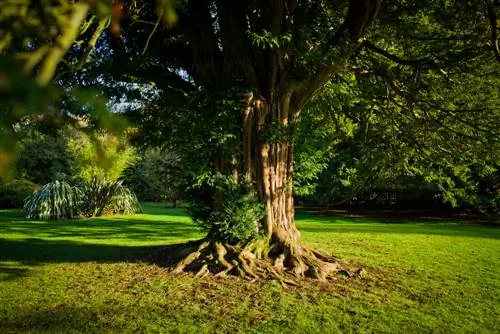- Author admin [email protected].
- Public 2023-12-16 16:46.
- Last modified 2025-01-23 11:21.
As classic pioneer plants, birches do not require much in order to thrive. A few points are even more important. In addition to sufficient light, the most important thing for the picturesque plants of the Betula genus is enough space. This is mainly due to their root type: birches are typically shallow-rooted.

What is special about birch roots?
Birches are shallow-rooted trees whose root system spreads directly below the surface of the earth and thus absorbs surface water for liquid and nutrients. When choosing a location for a birch tree, sufficient space, distance from other shallow-rooted plants and good soil quality are important.
The root of the birch
Birches come in more than 50 different species. What they all have in common, however, is their root system, as birches are consistently shallow-rooted. This means that the trees spread their root network in a ring directly beneath the surface of the earth. Birch trees therefore absorb liquid and nutrients from the surface water that seeps into the ground. They prove to be extremely energetic competitors to all nearby plants that also have a shallow root system - and also to anything else that might get in the way, such as paved paths or light structures. In contrast to shallow-rooted birches, so-called deep-rooted trees such as firs and pines obtain their nutrient supply from several meters deep in the ground.
Effects of the choice of location
If you plan to plant a birch tree, you should definitely take its root type into account. This results in crucial criteria for the optimal choice of location. First of all, you should plan enough distance from other plants in the area, especially if they are also shallow-rooted. They would most likely not be able to cope with the energetic birch roots.
The closer company of deep-rooted people, on the other hand, should be uncomplicated, at least as far as the roots' fight for valuable water is concerned. Competition for light beyond the earth's surface could play a role here, as the birch needs a location with as much sun as possible or at least light partial shade.
Other sources of problems with shallow roots
Birches grow at least 30 meters tall and form very opulent crowns. For this reason alone, it is necessary to have enough space available when planning the garden. Since the shallow roots make their way very powerfully, nearby asph alted or otherwise built-up areas are also not entirely ideal. They could lose out against the ever-growing roots and crack or collapse.
Possible risk of falling
There is also widespread concern among gardening enthusiasts that shallow-rooted plants could fall over more easily in stormy weather conditions. After all, these types of trees are not so deeply anchored in the ground. In the case of birch, however, the all-clear can be given: the soil conditions would have to be extremely poor and dry to prevent the roots from finding a foothold. Simply make sure that the soil quality is suitable, slightly moist, loamy and peaty when planting, and the tree will anchor itself securely. Further precautionary measures will help you if you want to be on the safe side:
- secure young birch trees in the growth phase with a stake
- Secure the surrounding area from the risk of falling
- plan enough distance from power lines, playgrounds, garages and parking lots






